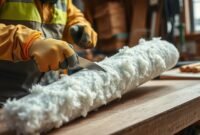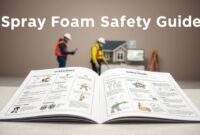Insulating block walls, particularly those made from existing concrete blocks, is a topic often overlooked in home improvement discussions. Yet, it’s essential for creating a comfortable, energy-efficient living environment. Proper insulation of these walls can significantly enhance the thermal performance of your home.
Whether you’re dealing with a new construction or an existing structure, understanding the ins and outs of block wall insulation can significantly affect your home’s comfort and energy costs.
What is the Best and Cheap Way to Insulate Block Walls?
Various methods can achieve insulation block walls, including those constructed with existing concrete blocks. However, the most effective and affordable techniques include rigid insulation, such as extruded polystyrene, spray, and injection foam insulation. These methods ensure the insulation materials fit snugly against the block walls, maximizing their insulating properties.
These methods provide excellent thermal resistance, reducing heat transfer and enhancing your home’s energy efficiency.

How to Insulate Walls Cheaply?
When it comes to insulating block walls, cost-effectiveness is a crucial factor. The goal is to achieve maximum insulation without incurring excessive costs.
● Rigid Foam Insulation
Rigid insulation, such as extruded polystyrene, is an affordable and straightforward method of insulating the interior of a block wall, including existing concrete block structures. These rigid foam boards are lightweight, easy to cut, and can be glued directly onto the concrete block wall, ensuring they fit snugly and provide effective insulation.
They can be used alone or with furring strips and drywall for a more finished look. They provide a layer of insulation that helps to reduce heat loss.
This method suits homeowners looking for a cost-effective solution that doesn’t require professional installation.
● Spray Foam Insulation
Spray foam insulation offers comprehensive coverage, particularly when applied to existing concrete block walls. It fills the voids in the blocks, creating a continuous layer of insulation that effectively reduces heat transfer. This method is ideal for ensuring the insulation fits snugly within the block cavities, enhancing its effectiveness.
The effectiveness of spray foam often justifies the additional cost. It’s an excellent option for homeowners willing to invest a bit more for a higher level of insulation.
Read also: Rigid Foam Over Batt Insulation, Why Not?
● Injection Foam Insulation
This method involves drilling holes into the wall and injecting foam into the cavities. Despite being a bit more labor-intensive, it’s particularly effective at filling all the pits and crevices in the block wall, providing a high level of insulation.
It suits homeowners looking for a comprehensive insulation solution, even requiring more effort and investment.
Do Block Walls Need to be Insulated?
Insulation is indeed necessary for block walls. Due to their porous nature, block walls allow for air movement and heat transfer. It can lead to significant heat loss, making your home less comfortable and increasing energy costs.
Without insulation, the heat from your home can easily escape through the block walls, especially during the colder months. In the summer, the heat from outside can penetrate the walls, making your home warmer and forcing your air conditioning system to work harder.
Insulating your block walls can help to maintain a consistent indoor temperature, regardless of the weather outside. It reduces the heat lost or gained through the walls, leading to lower energy consumption.
Moreover, insulation reduces noise, providing a quieter and more peaceful living environment. Therefore, insulating block walls is a practical and cost-effective way to enhance your home’s comfort and energy efficiency.
The Environmental Impact of Insulating Block Walls
Insulating block walls not only benefits homeowners in terms of comfort and cost savings, but it also positively impacts the environment.
Read also: Basement Wall Insulation Blanket
Insulation plays a crucial role in reducing fossil fuel usage and minimizing greenhouse gas release by reducing the amount of energy needed to heat or cool a home. Thus, it contributes to the fight against climate change and promotes a more sustainable future.
Moreover, many insulation materials are made from recycled or renewable resources, enhancing their environmental benefits. Therefore, insulating block walls is not just a smart choice for homeowners but also a responsible choice for the planet.
Finding a cheap way to insulate block walls does not mean compromising quality. With the right approach and materials, you can achieve excellent insulation at a fraction of the cost. Remember, a well-insulated home is more comfortable and energy-efficient!


